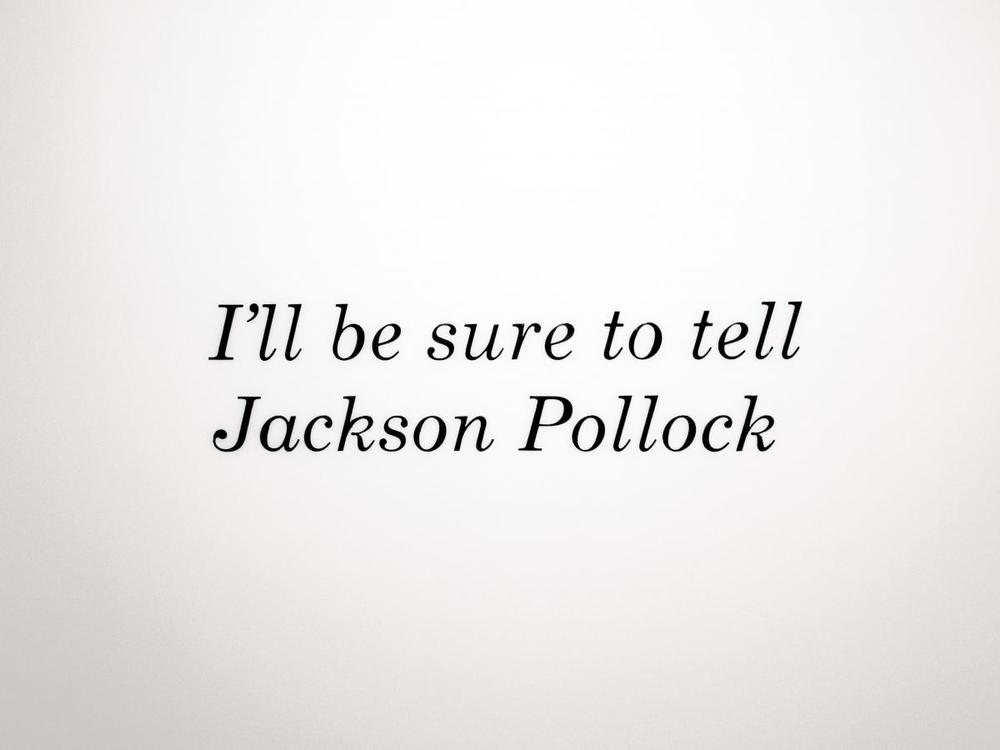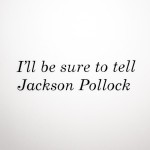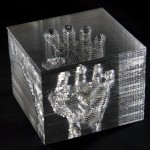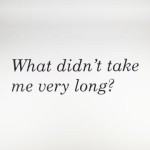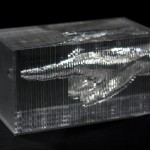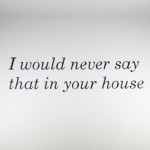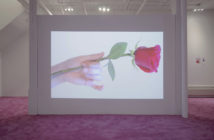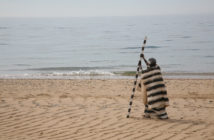Our conversation with Mittelman started off with a discussion of ASPECT’s origins. In 2003, the Internet was still young, and artists largely didn’t use it as a way to publish and promote their work. ASPECT filled a gap between other artists, curators and audiences, but moreover, it allowed an audience to experience an artwork simultaneously with its criticism. In so doing, ASPECT historicized New Media.
For the first twenty-minutes or so of that conversation, we didn’t realize that our recorder wasn’t recording. However, the ensuing conversation dealt not only with ASPECT’s importance in creating and evolving a New Media discourse, but with the logistics of actually producing a publication while working several other jobs. Mittelman is now making art work for the first time in about a decade, and spoke about his new work, the Boston art scene, as well as how he and Nofziger produced ASPECT for ten years.
Stephanie Cardon and Leah Triplett, BR&S [Press Record]
Michael Mittelman I’ve done that many times. One of my favorite moments was an issue where the person who was doing the production misspelled my name in the credits, and she was beyond mortified. I was like "Okay." First of all, Volume One had to be completely reprinted because it accidentally said "Volume Four," so I had all thousand DVDs and I had to print another thousand DVDs super rushed to get them by the opening on the Boston Cyberarts Festival. Moving forward to Volume 5, the audio was off on Matthew Nash’s piece, because it didn’t start at the beginning, and the guy who did the editing clipped it to the beginning and I didn’t notice and so everything was off by about a second and I had to publish a correction in Volume 6. Did that again in Volume 7, and the artist was not as okay with the correction, so I had to throw away about a thousand DVDs and reprint them. Let’s see, and that’s just our errors. I’m an avid reader of The Economist, and I love their corrections, like "last week we said so-and-so was a member of this terrorist organization. We were wrong, sorry."
BR&S [Laughs]
MM "Last week we said that more liberalization in the economy of Ecuador would be a good thing, we omitted the word 'not', sorry." So "el, le" I can live with that. It’s really not that bad.
All [Laughs]
BR&S Yeah, it’s much worse than not pressing record.
MM [laughing]Yeah. That’s the nature of this stuff.
BR&S It is, failure, error, glitches…
MM We did a volume on error! That was kind-of . . . unfortunately, that was not as diverse as I had hoped it would be. That was when we started ASPECT EZ. From the very beginning, I had this idea that I wanted to rope students in. So the first thing we did was, an educator’s portal. Jen Hall, who I was friends with, and who teaches Ed at MassArt, had her students writing lesson plans using an issue of ASPECT, and the idea was to publish these lesson plans, and then people could comment on them . . .
BR&S How cool.
MM If you think New Media is ahead of the curve, online lesson plan sharing was really ahead of the curve.
BR&S What year was this?
MM This was 2003. So that was crickets. Then we decided to start the Incubator. The Incubator was just an online forum for students, and the idea was "post your video, get other students to comment on it. . ." So I put on an online forum, and it got spammed [with]porn; it was just a porn-spam warehouse.
BR&S [Laughs]
MM So not very usable. And then, someone said, "what if we just ask for videos from artists and we’ll watch them and we’ll pick one and put it on our website." And I was like "Cool." So that was ASPECT EZ. The idea was that instead of needing a commentator, instead of needing a resume, just send us a video that’s no more than three minutes. We’re just going to look at the video. We actually got more submissions for that than we got for ASPECT. And the works were awesome. Because they were ideas. We were judging them for ideas, not for execution.
BR&S So how did you come up with themes?
MM In the beginning, I would come up with a theme. And the way I would come up with a theme where there was a piece I wanted. And I’d try to think up a theme that would help me get that piece. I never actually got that piece. Volume three was The Artist As Content. There was this amazing piece by Jonathan Bachrach where he made a photo-booth. He got an old Polaroid camera, that you could mechanically hold open, and then he got a photo-booth, and using computer software, [he’d] make line art out of a picture of you, and hold an LED in front of a Polaroid camera doing line art, and it’d spit out this Polaroid. He showed me a picture of him, and it didn’t look like him, but it looked like him. I was like this is so cool. You build a machine, you say "what do I look like?" and it says "You look like this." That’s so cool. I [thought]"what about self-portraiture in New Media?" And of course it needed to get a little bit broader, so it was The Artist As Content. Or, there are a number of times when Bill Arning was traveling. He’d come back from Mexico and say "We’ve got to do a show on Mexico." And I’d say "I can’t do a show on Mexico. How about South and Latin America? So you do your Mexico artist and we’ll go there." That’s how we did Artes dos Los Americas. Or, we’d do something that we either didn’t have enough of, or didn’t know enough about ourselves. Then there was one were we had a piece came in and I [thought]"I want to publish that piece. We need to find a theme where we can publish that piece." We debated for months what the Open Call should be, because . . . that was the one we ended up calling "Vital." We were like, do we want "Birth to Death," [or]"Cradle to Grave," all these things were going to give us this really specific thing, and we wanted a broader swath. We had to think about if we were going to get just video art, or just installation. How, with the call, do we sort of appeal to all genres of New Media, or just one? So we would deliberate a lot about what to call things. It was sort of like coming up with a good assignment as a teacher, you know something open ended that people can respond to in their own way that isn’t just your idea.
Bill Arning came back from Israel saying "You’ve got to do Israel!" And I [said]"I can’t do just Israel. For a whole bunch of reasons I can’t do just Israel." That actually ended up being a show at the Yerba Buena Center [for the Arts]. They just called us up and said "this is amazing. Can we show it?" And I [said]"Yes you can. I need to get permission from the artists, because that’s the one thing I don’t have permission for is to show it in a gallery setting, so let me ask the artists." They said "Absolutely." The show was born.
BR&S Well in a case like that though—well, let’s first start with the parameters that you set in terms of the kind of work that you are looking for. Because there’s installation, video, sound sculpture, performance documentation…
MM It’s always tough, because the people who do installation have to then make a good video. And it’s got to be a good video. They are basically going to have to start from scratch. As a person who did a lot of installation myself, it’s a lot of work. And I look back at my own documentation and I kind of cringe. The video artists, they’re giving away their work. So they don’t want to just give you the whole thing. With video artists, it became common to get an excerpt. It started with actually a Joan Jonas piece that EAI [Electronic Arts Intermix] had the rights to, and she wanted to let me publish it, but EAI was like, well she doesn’t have the right to say that. So we said, "well, why don’t we take, I don’t know, thirty seconds off the end?" and they were like "no problem." So it became this really weird thing where, as one gallerist put it, "So I’ll sell you that painting for a million dollars, or I’ll rip the corner off and give to you for five bucks." Because it lets them have their thing and we become a derivative, and they know that we are a derivative instead of the real thing. There were a number of EAI pieces where we would have to do a short edit. So in selecting the works, which I think is what you’re asking, the criteria were first, do we like the work? Do we find it interesting? The other thing which was also interesting was as an artist who submitted a lot of work to a lot of things, a lot of times it was about diversity. If there were two pieces that were sort of occupying the same space, one of them was going to get bumped out, even if it was a really good, strong piece. And there might be another piece that wasn’t as strong as that one, but showed a different arena. It was more important to have the artist cross-cut than to have the best work. And that’s where I think we were different from an exhibit. We weren’t about showing the best things. In fact, there were things that we showed, that we published that I actively disliked, but really wanted to publish, because it was about having material for discussion. Because, going back to the beginning, I felt like, and I still feel like, there was a dark ages of New Media art, when lots of things were happening but nobody knew about them. Because nobody was publishing it or distributing it or talking about it. Or if there was writing about it, it was writing in absence of the work. I just felt like the genre is not moving forward, because we’re not building on each other. The way that I knew that that was working was there’s never been an issue when everyone agreed on which was the best one and which was the worst one. If they had, that would have been a failure of an issue.
BR&S Right.
MM But the fact that everyone was like "oh no, that one’s the best, or, no, no, no, that’s definitely the worst," was good. I did exactly what I wanted to do, which was points of discussion, points of departure, something to build on, something to move from. So picking the work was definitely the fun part. It’s also the stressful part. You know, do we have enough to go with, what if somebody drops out . . .
BR&S So many variables.
MM So many variables. We’d ask ten, hoping to get five, sometimes we ended up getting eleven. We couldn’t schedule the recording session wherever everyone was, the curator is traveling for six months. We were literally like "well, what about this day in Tokyo? No? Well, what about this day in Frankfurt? Okay!" "We found a studio in LA on the 16th, can you do LA on the 16th? Great." A lot of the work was chasing down . . .
BR&S So you would find a sound studio for them?
MM Wherever they were.
BR&S Wow.
MM Yeah. Sometimes they’d say, oh, I can record it myself. Early on I was like "uh-unh." Now, they would say "I work at university and they have a recording studio." Fine, go ahead. Also, between my brother and the guy who did the audio post-production after he bowed out, they did a lot of magic. There were recordings that sounded like they’d stuffed the microphone in a pillow and walked into the next room and on the other side of things, it sounded really good. The other reason for using audio voice over was because it was cheaper than lighting and editing for video. Editing was a whole lot easier when I didn’t have to worry about continuity. Bill Arning would joke that I could put together an audio of him saying absolutely anything in the world, because at this point I have enough of his words.
BR&S Did you ever get a commentary that really sucked? How much did it matter that the commentary was as interesting as the video?
MM The commentary for me was gravy. Sometimes it was amazing gravy. Actually, [with]"Who Are You Entertaining To," the recording comes in, and she has perfect BBC diction. As a PBS kid, I was just like, "this is awesome."
BR&S [laughter]
MM And, what she was talking about was really amazing.
BR&S That’s more of what I meant. The content.
MM The content was you know, sometimes I liked it, sometimes I didn’t. It was always gravy. If I liked the piece, great, then the commentary was usually sort of addition. And sometimes it was a huge addition, and sometimes it was a very minor addition. I think it always helped the viewer put it [a work]in context if they didn’t know the work. It was something. There was no situation where I thought the commentary made it [a piece]worse. I’ve had that experience hearing artists talk, but that was why there was a rule that you can’t talk about yourself. You got to get someone else to talk about it. It raised the bar. You have to have accomplished enough as an artist to have found one friend who will talk about your work. And sometimes it’s just a buddy, but that’s actually a certain level of accomplishment. I think it just meant that the commentary was a little bit better. It wasn’t as much explanatory as it was expository.
BR&S You talk a lot about Bill. He was a board member?
MM Yep. [Bill Arning] was an advisor early on and then when we became a non-profit, which we didn’t do till 2009, he became a board member. There were certain curators who were just incredibly helpful and constant contributors. If you look back, I think there’s like a contest going between Bill Arning, George Fifield and Marissa Olson about who has participated the most. [Bill Arning] was a friend of mine and someone who’d shown me, and a fan of the work. Before I even met him he was described to me as an ‘art junkie.’ I think his record was doing a thousand studio visits in one year.
BR&S That’s like a myth at this point.
MM Yeah. It actually might have even been 1100. So he knew a lot of different people, and things going on. I would throw an idea at him, he’d be like, "oh yeah, what about this person?" He always had someone in his back pocket. I realized that most curators do have—most curators who are actively looking at artists—have lots of people in mind all the time, they are just looking for opportunities. I don’t know if that answers your question?
BR&S I was just wondering—your relationship with him seems particularly strong.
MM There were a lot of people. I think I couldn’t have done it without these relationships, especially with paying nobody anything. Which eventually became the problem with being a non-profit. There wasn’t a funding source that was small and interested in us to get us to the funding sources that were big and interested in us. The NEA was a total—I can’t believe that that happened. That was a throw-away application. And I got this very thin envelope. And I thought oh God, [and it said]"Dear Mr. Mittelman, We are really pleased…WHAT????"
ALL [laughter]
MM I was like "no. I didn’t get an NEA grant on my first try." Yes, I got an NEA grant on my first try.
BR&S So what did that grant enable you to do that you hadn’t done before?
MM Pay people who were interns and deserved to be paid. It helped pay for ASPECT EZ. Specifically, it paid for Volume 14. It got us to CAA [College Art Association] and ARLIS [Art Libraries Society of North America] and sort-of got us out there a lot. And that left some cash to actually help pay for the people who’d been working for free and volunteering their time. We really survived on interns for a lot of it. And I think in most cases they got at least as much out of it as we did. Cause it wasn’t ‘go get coffee’ internships, it was "design our outreach to university libraries" internship. So they were like, "Ok, cool." And they had a big feather in their cap. We tried to make it that way. But yeah, it was all about the relationships. Building relationships and maintaining relationships.
BR&S Let’s talk about your relationship with Boston a little bit. So you’ve said, it seems, that in each of the issues there are a couple of artists from this area.
MM Yeah. I don’t think I could have done it anywhere else, frankly. Just because, first of all, there’s a really strong network of international curators in Boston. They come through here a lot.
BR&S Because of the schools?
MM And the ICA, and yeah, the schools. MIT had Bill and Uta Meta Bauer. She got Isaac Julien, which was my dream from the very first day, to get an Isaac Julien video. International curators are in Boston, which helped me build my network and those relationships. Then there’s the fact that there’s one of everything happening in Boston. It may not be the best of that thing, but there’s definitely at least one of it happening here. If we needed a work, there was one here, waiting for us. And that helped us feel like if we did an open call, we’ve got one curator who should be able to bring something in. The number of artists who are working in different fields—Bill Arning used to call it [Boston] an incubator city. Then everybody moves off somewhere else, well sometimes they do, sometimes they don’t. But the number of active artists—New Media has actually been active in Boston, since the beginning, between the Cyberarts Festival, MIT and the [MassArt] Studio for Interrelated Media. So [Boston] has been a hub of that kind of work. And if you believe in the incubator theory, then these artists go somewhere else. That extends our network. Oh, Lana Caplan’s now in China. Great, we are doing an issue on China. Well, not only do we know somebody in China, we know a local artist in China. It makes it hard as a person who lives here to deal with all the turn-over, but it helps expand your network. So between the—how many art schools are there?
BR&S Too many to count.
MM [Laughs]. Yeah. And you know, the accessibility of cheap space. Relatively cheap space. We were in Fort Point for our first [few]years, then we were downstairs, and then up here. This space was always my studio also, so that covered the space aspect of it.
BR&S How did you juggle that? Artwork, career, job . . .
MM . . . Family. It got harder and harder. Every job I’ve had, the deal was, Wednesdays I have to be here. A lot of my work I’d try to do remotely, remotely from here. My artwork definitely waned, but that was probably more from being a parent than ASPECT. But it was a bit of juggling act. I think that was the other thing. Liz [Nofziger] had her two kids, and her art career, and it was like, "Ok. Something’s gotta give."
I’m actually making art again for the first time [since ASPECT], and I’ve got a show coming up for the first time in nine years . . . almost perfectly coinciding with ASPECT [laughs]. But I don’t think that has anything to do with it. But that’s what artists do. That’s the definition of being an artist, it’s you’re a multi-tasker because the 1% of the 1% of the 1% who get paid to make their work—the rest of us are finding ways to do multiple things. I would try to combine stuff as much as possible? But that actually worked out worse. I think people don’t like to see you wearing more than one hat. I never appeared in ASPECT. My saying was "when I have nothing to do with the choosing process, then I will submit my work, but until then, I’m going to stay out of it." Liz became an editor after she was in the magazine. We tried to keep a strong . . .
BR&S Divide?
MM Divide. Between us as artists and us as publisher and editor. But that’s what artists do. Especially New Media artists. [They] figure out how to use things that didn’t want to be used that way.
BR&S Are these yours? [References art works around the room]
MM Yeah, so what I’m doing now are lots of things with lasers. I went through a phase where I had a day job and the only time I could think about art when I was in an airplane. I started making art out of the Skymall catalogue. That piece behind you and the two in the hallway.
BR&S I love the Skymall catalogue. I read it for the humor [laughter]
MM But there’s art in there. The first thing I noticed was a Jenny Holzer with the LED scrollers. I was like "I could do a Jenny Holzer!" And it came pre-programmed with "No good deed goes unpunished."
BR&SSo you’ve ordered from the Skymall?
MM I’ve ordered thousands of things from the Skymall.
BR&S [Laughter] I don’t think I’ve actually ever talked to anyone who has ordered from the Skymall catalogue.
MM I actually called them up and asked them if I could put an ad in the Skymall catalogue for art that was made out of the Skymall catalogue.
BR&S Really?
MM They did not like that.
BR&S I would think they’d be all over that.
MM They did not like me making fun of them. So these two in the hall, these are these paintings that you could get where there’s an area where you could customize the text. So I would write ‘high art loves kitsch.’ I did four or five or six of those. Then they would tell me they were out of stock. I was like, "out of stock of the digital file? Ok, I get it, you don’t like me anymore. You don’t want my business."
[Laughter]
I was doing that, and then I sorta got tired of doing that. I’ve been obsessed with hands for a long time. My undergraduate thesis was all about computer models of hands, so I’m doing these hands where I take a model and then I just subtract it out of a block, and then I slice it, and then it reassembles a gesture.
BR&S Wow.
MM So you can see what a slice looks like [shows us a slice]It comes together and falls apart. The Rodin one was the first one I did, and I was putting it together and I didn’t know what it was going to look like until I started peeling off the plastic and stacking it. So I’m having fun with those. And then the texts pieces.
BR&S Yeah?
MM So part of the deal with this studio is that I have to do open studios. But I’m not your typical open studios artist. I would get a lot of rude things said. And it’s your space!
MM People would come in and say things like ‘this is why I hate Modern art.’ So that’s what I was thinking about when I made that [references text that reads: "I’ll be sure to tell Jackson Pollock."].
BR&S So these are answers.
MM These are answers to things said. I studied architecture, so these are actually ink on Mylar, they are hand-inked. I laser-cut a stencil, and I hand-inked them. So everything in here is done with lasers. Now I’m re-building my network as an artist. I’m calling curators and asking them for studio visits for the first time in five or six or seven years.
BR&S How would you say running ASPECT for ten years has had on you as an artist? Looking at all that work?
MM It’s made me much more thick-skinned. Because I understand what it’s like to be on the other side. You weren’t rejected because your work was bad, you were rejected because there was a vision of how this thing would fit together and your work didn’t fit perfectly into that vision, [but]I might love your work.
BR&S Right.
MM I think it’s definitely given me a lot of ideas. I get inspired by work all the time. I have a much better idea of how I failed in my last go-around as an artist. Which was, I was doing large-scale installation, and the documentation just didn’t convey the work.
I had a great career in Boston, because people who saw my work got it. But whenever I tried to send documentation to New York or California, people would look at the documentation and they didn’t get it.
Looking back at my documentation, I can see why. It just wasn’t capturing that. And so when I talk to students, I always [tell them]90% of the people who are going to see your work are going to see documentation. And if you’re really a successful artist, it’s 89%.
BR&S True.
MM It also raised my standards for a lot of things. There’s work I don’t want to do, because my standards for, for instance, video, have gotten so high that I don’t think I can compete in that realm. I know what I would look for, and I couldn’t pull it off. I don’t have the skills right now. It’s interesting because when I was clearly a New Media artist, it was a small pond, so it was easy to stand out. It’s no longer a small pond. But even so, stepping out of that into the rest of the pond is a much bigger pond, it’s actually even harder to stand out. I think I’m aware of having a space that I can claim as my own. And I’m aware of what it means to do what other people have done. The thing that’s kind-of interesting about this is that for the first time in my life, I’m making work that I think has some commercial viability. So now I’m worried about somebody copying it?
BR&S Hmm.
MM Which has never been an issue before because who the hell would want to copy my stuff that nobody wanted to buy? So now there’s the "well, what if somebody starts copying it?" And as the editor, when an artist would say, "well, I don’t want to just give you my stuff, because everyone’s going to see it," I would say "that’s the point." Now as an artist I have to say "you know what, even if they copy it, I think that I have something as an artist, a particular point of view, the countless number of hours that I’ve spent studying the hand and hand gestures, and understanding what the flex of different joints implies, that yes, you can figure out what software I’m using, and how I’m making it, but it’s still rooted in the idea and the craft of the gesture. And that’s what art is.
BR&S Right.
MM So if you’re really worried as an artist about someone stealing your work, then you’re not confident that you actually have any art in there. Because the art is the unstealable part.
I think ASPECT helped me find my way through that as I’m entering a more commercially viable space. As opposed to giant installations that were 10 ft x 15 ft x 30 ft and had ten thousand dollars in electronics running in them.
BR&S [Laughter]
MM That was not a concern.
BR&S What the sense that you got from artists about the impact that the publication had with them?
MM [Laughter] That was actually one of the most frustrating aspects of it. On the one hand I really tried to make the magazine about the artists. Editorially, it was very thin. My name only appeared if you happened to click on the credits. It wasn’t about the people that made the magazine. It was about the people who made the work. The artists got a lot of great press and publicity from being in ASPECT, and so did the commentators. I was getting stories about people getting tenure for having appeared in ASPECT.
BR&S Wow.
MM And meanwhile I couldn’t get a teaching gig.
ALL [Laughter]
MM Yeah. And the curators who were apart of it really liked what it did, they liked what it did for New Media, they really appreciated it for having [it]as material they could show in their classroom. The emails I got when we announced we were shutting down were really, really nice. Both from the artists and from the commentators. So I think it did a lot. I don’t think it launched anyone’s career. In fact, I kind of hope not. I don’t want to take that kind of credit. But I think that—I’d like to think that it helped the genre in general.
And, at the end, looking back, we really did what we came to do. There’s now a collection out there. If you want to talk about video, there’s some stuff and people talking about it. I think the one thing that’s going to be missing with ASPECT shutting down is we’re still the only place where the content and the criticism are together. I wish people would pick up on how important that is. People say "what’s next for ASPECT?" And I say "well, if there was going to be a next, it would just be a website with guest writers writing about a work if they could include a link to the work itself. Because now the artists are publishing the art themselves. But [we would]say "look, I’m not just going to talk about a thing and can’t see it. I’m going to talk about a thing and actually let you see it." Even the reviews of ASPECT are a review of a thing that you have to go and buy. But the idea of ‘look at a work, let’s talk about the work, look at it again,’ which is sort of the best experience you can have with an artwork, that’s still really missing. And I hope somebody notices.
- Michael Mittelman, I’ll be sure to tell Jackson Pollock, 2013, hand drawn ink on Mylar, 24 x 36 inches.
- Michael Mittelman, hand.001 (Way after Rodin), 2013, stacked acrylic, 6 x 7 x 5 inches.
- Michael Mittelman, hand.002, 2013, stacked acrylic, 4 x 4 x 6 inches.
- Michael Mittelman, What didn’t take me very long?, 2013, hand drawn ink on Mylar, 24 x 36 inches.
- Michael Mittelman, hand.002, 2013, stacked acrylic, 4 x 4 x 6 inches.
- Michael Mittelman, I would never say that in your house, 2013, hand drawn ink on Mylar, 24 x 36 inches.
- Michael Mittelman, hand.005, 2013, stacked acrylic, 5 x 6 x 4 inches.

